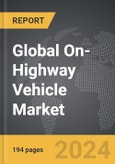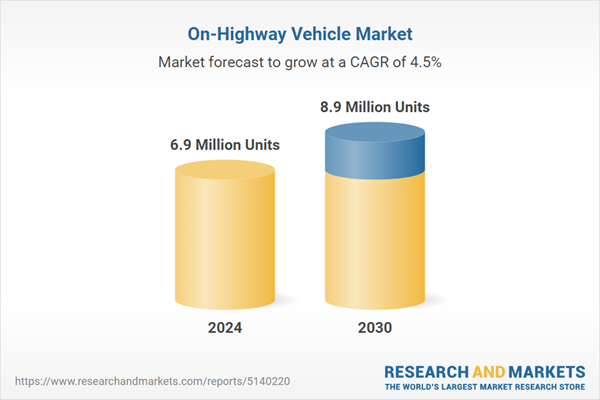Global On-Highway Vehicle Market - Key Trends & Drivers Summarized
What Defines On-Highway Vehicles and Why Is the Market Evolving?
On-highway vehicles refer to vehicles designed for use on public roads, including passenger cars, trucks, buses, and commercial vehicles. These vehicles are essential for personal transportation, goods delivery, and public transit in urban and rural areas. The on-highway vehicle market is witnessing rapid evolution due to technological advancements, changing consumer preferences, and regulatory pressures aimed at reducing emissions and improving fuel efficiency. With the rise of electric vehicles (EVs), autonomous driving technologies, and connectivity features, the market is experiencing a transformative shift. These innovations are not only enhancing vehicle performance and safety but also reshaping how consumers and businesses approach mobility and logistics, making the on-highway vehicle market a dynamic sector to watch.How Are Technological Advancements Revolutionizing On-Highway Vehicles?
The on-highway vehicle market is being transformed by several technological innovations, particularly in the areas of electrification, autonomous driving, and connected vehicle technologies. Electric vehicles (EVs) are gaining significant market share as automakers ramp up production and governments offer incentives to promote cleaner transportation. Advances in battery technology, such as longer range and faster charging capabilities, are making EVs more practical for everyday use, while reducing their total cost of ownership. Autonomous driving technologies, including advanced driver-assistance systems (ADAS) and full self-driving (FSD) capabilities, are also rapidly progressing, enhancing safety and convenience for drivers. Moreover, vehicle-to-everything (V2X) communication is enabling cars to interact with infrastructure and other vehicles, improving traffic management and reducing accidents. These technological trends are reshaping the landscape of on-highway vehicles, making them smarter, safer, and more sustainable.Why Are Consumer Preferences and Regulations Shaping the Future of On-Highway Vehicles?
Consumer preferences are shifting towards environmentally friendly, connected, and safer vehicles, driving demand for electric vehicles (EVs) and hybrid models. Growing environmental awareness, coupled with rising fuel prices, is pushing consumers to opt for more energy-efficient and sustainable options. Additionally, urbanization and changing lifestyles are boosting the demand for shared mobility solutions and electric buses, which contribute to reduced congestion and emissions. On the regulatory front, governments worldwide are implementing stringent emission standards and offering incentives for the adoption of low-emission vehicles, accelerating the transition to electric and hybrid vehicles. At the same time, safety regulations are mandating the inclusion of advanced driver-assistance systems (ADAS), pushing automakers to integrate cutting-edge safety features. These regulatory and consumer trends are shaping the future of on-highway vehicles, driving innovation and market growth.What Factors Are Driving Growth in the On-Highway Vehicle Market?
The growth in the on-highway vehicle market is driven by several factors, most notably the increasing shift towards electric vehicles (EVs) and stringent emissions regulations. The global push for reducing carbon emissions and combating climate change has led to heightened demand for EVs and hybrid vehicles, which are more environmentally friendly. Government incentives, such as tax credits and subsidies for EV buyers, along with expanded charging infrastructure, are further accelerating the adoption of electric vehicles. Advances in autonomous driving technology and vehicle connectivity are also driving growth, as consumers seek safer and more convenient driving experiences. Moreover, the growing e-commerce sector is fueling demand for commercial vehicles, particularly trucks and delivery vans, to support last-mile logistics. As urbanization continues and cities expand, the demand for on-highway public transport, including electric buses, is also on the rise, contributing to the overallexpansion of the on-highway vehicle market. Additionally, investments in smart infrastructure and the integration of vehicle-to-infrastructure (V2I) technologies are improving traffic efficiency, further driving the adoption of advanced on-highway vehicles. The global shift towards sustainable transportation solutions, combined with technological innovation, is expected to sustain robust growth in this market for years to come.
Report Scope
The report analyzes the On-Highway Vehicle market, presented in terms of units. The analysis covers the key segments and geographic regions outlined below.Segments: Vehicle Type (Trucks, Buses, Recreational Vehicles).
Geographic Regions/Countries: World; United States; Canada; Japan; China; Europe (France; Germany; Italy; United Kingdom; Spain; Russia; and Rest of Europe); Asia-Pacific (Australia; India; South Korea; and Rest of Asia-Pacific); Latin America (Argentina; Brazil; Mexico; and Rest of Latin America); Middle East (Iran; Israel; Saudi Arabia; United Arab Emirates; and Rest of Middle East); and Africa.
Key Insights:
- Market Growth: Understand the significant growth trajectory of the Trucks segment, which is expected to reach 4.7 Million Units by 2030 with a CAGR of a 5.2%. The Buses segment is also set to grow at 4.2% CAGR over the analysis period.
- Regional Analysis: Gain insights into the U.S. market, sized at 1.8 Million Units in 2024, and China, forecasted to grow at an impressive 7.0% CAGR to reach 2.0 Million Units by 2030. Discover growth trends in other key regions, including Japan, Canada, Germany, and the Asia-Pacific.
Why You Should Buy This Report:
- Detailed Market Analysis: Access a thorough analysis of the Global On-Highway Vehicle Market, covering all major geographic regions and market segments.
- Competitive Insights: Get an overview of the competitive landscape, including the market presence of major players across different geographies.
- Future Trends and Drivers: Understand the key trends and drivers shaping the future of the Global On-Highway Vehicle Market.
- Actionable Insights: Benefit from actionable insights that can help you identify new revenue opportunities and make strategic business decisions.
Key Questions Answered:
- How is the Global On-Highway Vehicle Market expected to evolve by 2030?
- What are the main drivers and restraints affecting the market?
- Which market segments will grow the most over the forecast period?
- How will market shares for different regions and segments change by 2030?
- Who are the leading players in the market, and what are their prospects?
Report Features:
- Comprehensive Market Data: Independent analysis of annual sales and market forecasts in US$ Million from 2024 to 2030.
- In-Depth Regional Analysis: Detailed insights into key markets, including the U.S., China, Japan, Canada, Europe, Asia-Pacific, Latin America, Middle East, and Africa.
- Company Profiles: Coverage of players such as Bentley Motors, Camec Pty Ltd, G H Varley Pty Limited, GAZ international LLC, Karosserie Moeyersons NV and more.
- Complimentary Updates: Receive free report updates for one year to keep you informed of the latest market developments.
Some of the 41 companies featured in this On-Highway Vehicle market report include:
- Bentley Motors
- Camec Pty Ltd
- G H Varley Pty Limited
- GAZ international LLC
- Karosserie Moeyersons NV
- MAN SE
- Thomas Built Buses, Inc.
- Tofas Turk Otomobil Fabrikasi A.S.
- Toyota Auto Body Co., Ltd.
- Toyota Motor Corporation
Tariff Impact Analysis: Key Insights for 2025
Global tariff negotiations across 180+ countries are reshaping supply chains, costs, and competitiveness. This report reflects the latest developments as of April 2025 and incorporates forward-looking insights into the market outlook.The analysts continuously track trade developments worldwide, drawing insights from leading global economists and over 200 industry and policy institutions, including think tanks, trade organizations, and national economic advisory bodies. This intelligence is integrated into forecasting models to provide timely, data-driven analysis of emerging risks and opportunities.
What’s Included in This Edition:
- Tariff-adjusted market forecasts by region and segment
- Analysis of cost and supply chain implications by sourcing and trade exposure
- Strategic insights into geographic shifts
Buyers receive a free July 2025 update with:
- Finalized tariff impacts and new trade agreement effects
- Updated projections reflecting global sourcing and cost shifts
- Expanded country-specific coverage across the industry
Table of Contents
Companies Mentioned (Partial List)
A selection of companies mentioned in this report includes, but is not limited to:
- Bentley Motors
- Camec Pty Ltd
- G H Varley Pty Limited
- GAZ international LLC
- Karosserie Moeyersons NV
- MAN SE
- Thomas Built Buses, Inc.
- Tofas Turk Otomobil Fabrikasi A.S.
- Toyota Auto Body Co., Ltd.
- Toyota Motor Corporation
Table Information
| Report Attribute | Details |
|---|---|
| No. of Pages | 194 |
| Published | April 2025 |
| Forecast Period | 2024 - 2030 |
| Estimated Market Value in 2024 | 6.9 Million Units |
| Forecasted Market Value by 2030 | 8.9 Million Units |
| Compound Annual Growth Rate | 4.5% |
| Regions Covered | Global |









